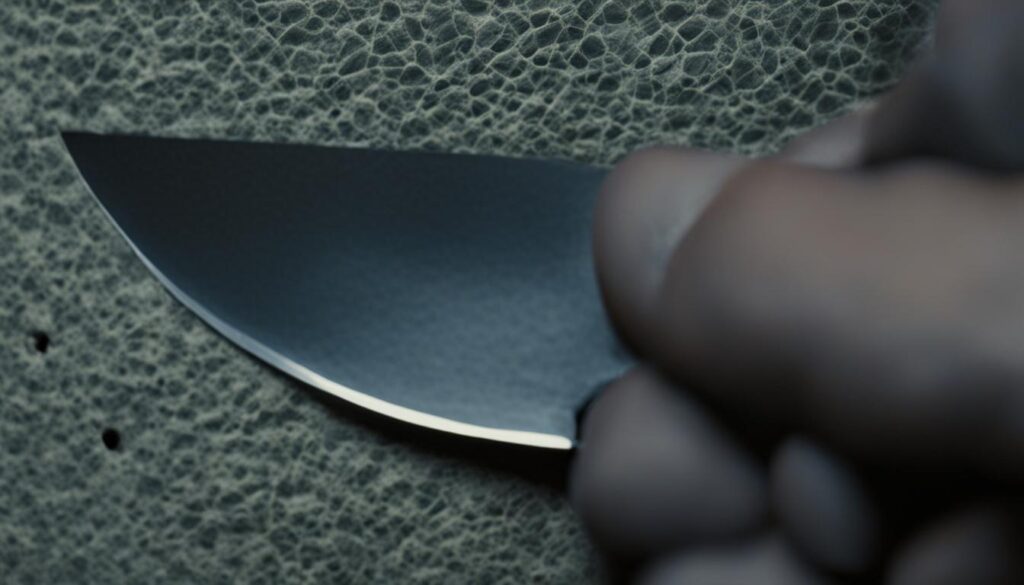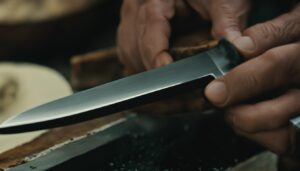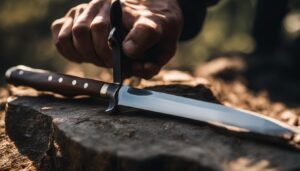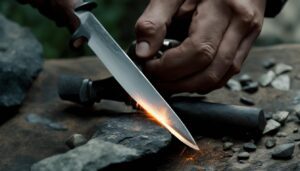Hunting knives are essential for hunters, but over time they can lose their sharpness, making hunting and other outdoor activities more difficult and dangerous. That’s why it’s important to master the skill of sharpening hunting knives. This guide will provide you with everything you need to know about choosing the best sharpening stones for hunting knives.
Key Takeaways:
- Choosing the right sharpening stones for hunting knives is crucial for maintaining their sharpness and performance.
- The type of knife you have will affect the sharpening process, so it’s important to use the appropriate sharpening tools for each blade design.
- There are different types of sharpening tools available, including sharpening stones, honing rods, electric sharpeners, pull-through sharpeners, and guided sharpening systems.
- Before sharpening your hunting knife, make sure to clean the blade, check for nicks and chips, determine the correct sharpening angle, and choose the most suitable sharpening method.
- When sharpening a hunting knife using a whetstone, remember to apply light pressure, maintain a consistent angle, remove any burrs, and polish the edge using a honing rod.
How the Type of Knife Affects the Sharpening Process
When it comes to sharpening hunting knives, it’s important to understand that the type of knife you have will impact the sharpening process. Different blade designs require different sharpening techniques to achieve optimal results.
For instance, a drop point knife is known for its curved edge. To sharpen this type of knife effectively, you may need a sharpening stone with a rounded edge that can follow the blade’s curve seamlessly. This allows for precise sharpening and ensures that the knife retains its original shape.
On the other hand, a clip point knife features a straight edge. This makes it easier to sharpen with a straight-edged sharpening stone. You can maintain a consistent angle and apply even pressure to achieve a sharp and durable edge.
Other types of hunting knives, such as gut hook knives, Bowie knives, and skinning knives, each have their own unique blade designs that require specific sharpening techniques. Understanding the characteristics of your knife will help you choose the right sharpening tools and methods for optimal results.
Sharpening Techniques for Different Knife Types
Here’s a breakdown of the sharpening techniques for different types of hunting knives:
- Drop Point Knife: Use a sharpening stone with a rounded edge to follow the blade’s curve and maintain its shape.
- Clip Point Knife: Sharpen with a straight-edged sharpening stone, maintaining a consistent angle and applying even pressure.
- Gut Hook Knife: Pay special attention to sharpening the gut hook, as it requires a precise and careful technique to ensure optimal performance.
- Bowie Knife: Utilize a combination of sharpening methods, such as honing and stropping, to achieve a razor-sharp edge.
- Skinning Knife: Focus on maintaining a sharp and narrow edge to ensure clean and efficient skinning.
By understanding the unique characteristics of each knife type and employing the appropriate sharpening techniques, you can keep your hunting knives in top condition for years to come.
Different Types of Sharpening Tools
When it comes to sharpening your hunting knife, there are several types of sharpening tools to choose from. Each tool has its own advantages and considerations, so it’s important to understand the options available to you.
Sharpening Stone: A sharpening stone, also known as a whetstone, is a classic and versatile tool for sharpening hunting knives. It requires some practice and patience to use effectively, but it allows you to maintain complete control over the sharpening process.
Honing Rod: A honing rod is another useful tool for maintaining the sharpness of your hunting knife. It is used to straighten and refine the edge of the blade, ensuring that it remains at its optimal sharpness. Unlike a sharpening stone, a honing rod does not remove much material from the blade.
Electric Sharpener: If you’re looking for a quick and easy sharpening option, an electric sharpener may be the right choice for you. These tools use a motorized mechanism to rapidly sharpen the blade. However, it’s important to use caution as they can remove too much material if not used correctly.
Pull-Through Sharpener: A pull-through sharpener is a compact and portable option for sharpening your hunting knife. It typically consists of two sharpening rods set at a specific angle. While it offers convenience, it may be less precise than other sharpening tools.
Guided Sharpening System: A guided sharpening system is an excellent option for beginners or those who want a precise and easy-to-use tool. These systems typically include a clamp or guide to hold the blade at the correct angle, ensuring consistent and accurate sharpening.

When choosing a sharpening tool for your hunting knife, consider your skill level, the type of knife you have, and your personal preferences. It’s important to find a tool that you feel comfortable using and that allows you to achieve the desired level of sharpness for your hunting needs.
Preparing Your Hunting Knife For Sharpening
Before you start sharpening your hunting knife, it’s important to properly prepare it to ensure the best results. Follow these steps to get your knife ready for sharpening:
- Clean the blade: Begin by cleaning the blade of your hunting knife to remove any dirt, residue, or debris. This will ensure that you have a clean surface to work with during the sharpening process.
- Check for nicks and chips: Carefully examine the blade for any nicks or chips. These imperfections can affect the overall performance of the knife. If you notice any, use a file to smooth them out before moving forward with sharpening.
- Determine the angle: Next, you’ll need to determine the correct sharpening angle for your hunting knife. The angle at which you sharpen the blade can impact its cutting ability. Research the recommended angle for your specific knife, or use a sharpening guide to help you find the optimal angle.
- Choose a sharpening method: There are various sharpening methods available, including sharpening stones, honing rods, and electric sharpeners. Consider your skill level and the type of knife you have when selecting the best method for sharpening. Each method has its own benefits and learning curve.
By properly cleaning your knife, checking for any damage, determining the correct angle, and selecting the appropriate sharpening method, you’ll be well-prepared to begin sharpening your hunting knife and achieve a sharp, efficient cutting edge.


Preparation Checklist:
Use this checklist to ensure you’ve properly prepared your hunting knife for sharpening:
- Knife blade is clean and free from dirt or debris
- No nicks or chips are present on the blade
- Correct sharpening angle has been determined
- Appropriate sharpening method has been chosen
Sharpening Methods Comparison
| Sharpening Method | Pros | Cons |
|---|---|---|
| Sharpening Stones | Provides precise control over the sharpening process | Requires practice to master the technique |
| Honing Rod | Straightens and maintains the blade’s edge | Does not remove significant amounts of material, mainly used for maintenance |
| Electric Sharpener | Quick and easy to use | May remove too much material if not used correctly |
| Pull-Through Sharpener | Compact and portable | May be less precise compared to other methods |
| Guided Sharpening System | Easy to use, especially for beginners | May require an additional investment |
Remember, each sharpening method has its own advantages and disadvantages. Consider your skill level and preferences when choosing the method that best suits you and your hunting knife.
How To Sharpen A Hunting Knife Using A Whetstone
Sharpening a hunting knife using a whetstone is a skill that can restore its sharpness and enhance its performance in the field. Follow these steps to achieve a razor-sharp edge:
- Prepare the whetstone: Place the sharpening stone securely on a flat surface. Ensure that it is clean and free from any debris.
- Determine the desired sharpening angle: Different hunting knives have varying sharpening angles. Refer to the manufacturer’s instructions or consult a sharpening angle guide to determine the correct angle for your specific knife.
- Apply light pressure: Hold the knife with a firm grip and position the blade against the whetstone at the desired sharpening angle. Apply light pressure as you move the blade back and forth along the stone in a sweeping motion.
- Maintain a consistent angle: It is crucial to maintain a consistent angle throughout the sharpening process. This ensures that the edge is sharpened evenly and results in a precise cutting edge.
- Remove burrs: After several passes on each side of the blade, check for burrs along the edge. Burrs are small metal particles that can interfere with the knife’s cutting ability. Remove them by lightly running the blade along a honing rod at the same sharpening angle.
- Polish the edge: Once the burrs are removed, continue sharpening until the desired sharpness is achieved. To further refine the edge, lightly polish it by making a few passes on each side of the blade using the whetstone.
Finally, wipe the blade clean to remove any residual metal particles and apply a light coating of oil to protect the newly sharpened edge from rust and corrosion. Regular maintenance and sharpening will ensure that your hunting knife remains sharp and ready for any outdoor adventure.
Conclusion
Having a sharp hunting knife is crucial for any hunting expedition. By choosing the right hunting knife sharpeners and knife sharpening stones, you can ensure that your hunting knife remains sharp and performs efficiently and safely in the field.
Remember to properly prepare your hunting knife before sharpening, use the appropriate sharpening tools, and maintain a consistent angle throughout the sharpening process. With patience and practice, you can keep your hunting knives sharp for longer periods of time, making your hunting experience more enjoyable and successful.
Investing in high-quality hunting knife sharpeners and knife sharpening stones is well worth it, as they will help you maintain the sharpness and durability of your hunting knives. Whether you choose a sharpening stone, honing rod, electric sharpener, pull-through sharpener, or guided sharpening system, make sure to follow the instructions and take your time to achieve optimal results.
FAQ
What type of sharpening stone should I choose for my hunting knife?
The type of sharpening stone you choose will depend on the type of hunting knife you have. Different blade designs require different sharpening techniques. For example, a drop point knife may require a sharpening stone with a rounded edge to follow the blade’s curve, while a clip point knife can be sharpened with a straight-edged sharpening stone.
What are the different types of sharpening tools available for hunting knives?
There are various types of sharpening tools available for hunting knives. These include sharpening stones (also known as whetstones), honing rods, electric sharpeners, pull-through sharpeners, and guided sharpening systems.
How do I prepare my hunting knife for sharpening?
Before sharpening your hunting knife, it’s important to clean the blade to remove any dirt or debris. Check for any nicks or chips and smooth them out with a file if necessary. Determine the correct sharpening angle for your knife. Choose the sharpening method that best suits your skill level and the type of knife you have.
How do I sharpen a hunting knife using a whetstone?
To sharpen a hunting knife using a whetstone, hold the sharpening stone securely on a flat surface. Place the knife blade against the stone at the desired sharpening angle and apply light pressure. Move the blade back and forth along the stone in a sweeping motion, maintaining a consistent angle. Alternate between sides and increase the pressure slightly with each pass. Check the sharpness of the blade by running your finger along the edge. Remove any remaining burrs and polish the edge using a honing rod. Finish by wiping the blade clean and applying a light coating of oil.
Why is it important to have a sharp hunting knife?
Having a sharp hunting knife is crucial for any hunting expedition. A sharp knife allows for cleaner and more efficient cuts, making hunting and other outdoor activities safer and easier. A dull knife can be more dangerous as it requires more force to cut and can slip, leading to accidents.





